A) income and wealth.
B) stocks and flows.
C) injections and leakages.
D) leakages and injections.
Correct Answer

verified
Correct Answer
verified
Multiple Choice
The open economy multiplier is:
A) larger than the simple multiplier because the latter embodies fewer leakages.
B) larger than the simple multiplier because the latter embodies more leakages.
C) smaller than the simple multiplier because the latter embodies fewer leakages.
D) smaller than the simple multiplier because the latter embodies more leakages.
Correct Answer

verified
Correct Answer
verified
Multiple Choice
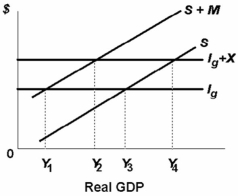 -In the above private open economy, international trade:
-In the above private open economy, international trade:
A) is inflationary.
B) is a source of additional jobs for domestic workers.
C) has no effect on GDP.
D) has a contractionary effect on GDP.
Correct Answer

verified
Correct Answer
verified
Multiple Choice
Suppose the economy is operating at its full-employment-noninflationary GDP and the MPC is 0.75. The federal government now finds that it must increase spending on military goods by $21 billion in response to a deterioration in the international political situation. To sustain full-employment-noninflationary GDP government must:
A) reduce taxes by $28 billion.
B) reduce transfer payments by $21 billion.
C) increase taxes by $21 billion.
D) increase taxes by $28 billion.
Correct Answer

verified
Correct Answer
verified
Multiple Choice
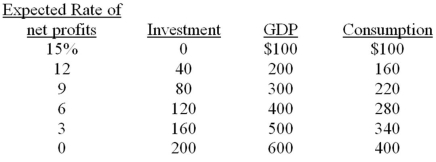 -Refer to the above data. If gross investment is $120, the equilibrium level of GDP will be:
-Refer to the above data. If gross investment is $120, the equilibrium level of GDP will be:
A) $380.
B) $370.
C) $360.
D) $400.
Correct Answer

verified
Correct Answer
verified
Multiple Choice
If Canada wants to increase its net exports, other things equal, it might take steps to:
A) increase its GDP.
B) reduce existing tariffs and import quotas.
C) decrease the dollar price of foreign currencies.
D) increase the dollar price of foreign currencies.
Correct Answer

verified
Correct Answer
verified
Multiple Choice
Refer to the above diagram for a private closed economy. At the $400 level of GDP:
A) aggregate expenditures exceed GDP with the result that GDP will rise.
B) consumption is $350 and planned investment is zero so that aggregate expenditures are $350.
C) consumption is $300 and planned investment is $50 so that aggregate expenditures are $350.
D) consumption is $300 and actual investment is $100 so that aggregate expenditures are $400.
Correct Answer

verified
Correct Answer
verified
Multiple Choice
Imports have the same macroeconomic effect on GDP as:
A) exports.
B) investment.
C) consumption.
D) saving.
Correct Answer

verified
Correct Answer
verified
Multiple Choice
The letters Y, C, S, and I are used to represent GDP, consumption, saving, and investment respectively.
 -The equation representing the investment schedule for the above economy is:
-The equation representing the investment schedule for the above economy is:
A) I = .3Y.
B) I = 80 -.3Y.
C) I = 30 + .1Y.
D) I = I0 = 30.
Correct Answer

verified
Correct Answer
verified
Multiple Choice
If government increases lump-sum taxes by $20 billion and the economy's MPC is .6, then the:
A) consumption schedule will shift upward by $12 billion.
B) consumption schedule will shift downward by $12 billion.
C) equilibrium GDP will increase by $40 billion.
D) equilibrium GDP will decrease by $12 billion.
Correct Answer

verified
Correct Answer
verified
Multiple Choice
For a private closed economy, an unplanned decline in inventories suggests that:
A) aggregate expenditures are less than the business sector expected them to be.
B) planned investment is greater than saving.
C) actual investment exceeds saving.
D) planned investment is greater than consumption.
Correct Answer

verified
Correct Answer
verified
Multiple Choice
Suppose that a mixed open economy is producing at its equilibrium level of income and that net exports are zero. If at the equilibrium income level the public sector's budget shows a surplus:
A) Ca + Ig + Xn + G must exceed GDP.
B) planned investment must exceed saving.
C) a recessionary expenditure gap must exist.
D) saving must exceed planned investment.
Correct Answer

verified
Correct Answer
verified
True/False
A $10 billion decrease in taxes will increase the equilibrium GDP by more than would a $10 billion increase in government expenditures.
Correct Answer

verified
Correct Answer
verified
Multiple Choice
The letters Y, C, S, and I are used to represent GDP, consumption, saving, and investment respectively.
 -The equation representing the consumption schedule for the above economy is:
-The equation representing the consumption schedule for the above economy is:
A) C = Y - .6S.
B) Y = C + S.
C) C = 60 + .4Y.
D) C = 60 + .6Y.
Correct Answer

verified
Correct Answer
verified
Multiple Choice
The following information is for a closed economy:
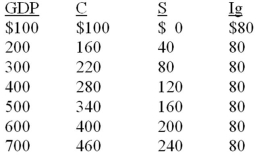 -Refer to the above information. If government now spends $80 billion at each level of GDP and taxes remain at zero, the equilibrium GDP:
-Refer to the above information. If government now spends $80 billion at each level of GDP and taxes remain at zero, the equilibrium GDP:
A) will rise to $700.
B) will rise to $600.
C) will rise to $500.
D) may either rise or fall.
Correct Answer

verified
Correct Answer
verified
Multiple Choice
If a lump-sum tax of $40 billion is imposed and the MPC is 0.6, the saving schedule will:
A) shift downward by $24 billion.
B) shift upward by $24 billion.
C) shift downward by $16 billion.
D) shift upward by $16 billion.
Correct Answer

verified
Correct Answer
verified
Multiple Choice
If government increases its purchases by $15 billion and the MPC is 2/3, then we would expect the equilibrium GDP to:
A) increase by $30 billion.
B) increase by $45 billion.
C) decrease by $35 billion.
D) increase by $50 billion.
Correct Answer

verified
Correct Answer
verified
Multiple Choice
The table shows the consumption schedule for a hypothetical economy. All figures are in billions of dollars.
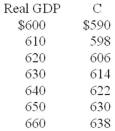 -Refer to the above table. If taxes were $5, government purchases of goods and services $10, planned investment $6, and net exports zero, equilibrium real GDP would be:
-Refer to the above table. If taxes were $5, government purchases of goods and services $10, planned investment $6, and net exports zero, equilibrium real GDP would be:
A) $600.
B) $610.
C) $620.
D) $630.
Correct Answer

verified
Correct Answer
verified
Multiple Choice
Refer to the diagram below for a private closed economy. The multiplier is: 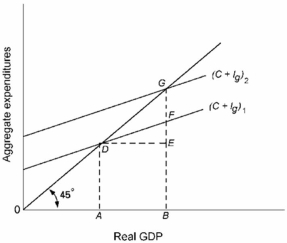
A) GF/DE.
B) GF/GB.
C) FE/GF.
D) AB/GF.
Correct Answer

verified
Correct Answer
verified
Multiple Choice
 -Refer to the above diagram where Ig is gross investment, X is exports, G is government purchases, S and Sa are saving before and after taxes respectively, M is imports, and T is net taxes, that is, taxes less transfers. The equilibrium level of GDP for this economy is:
-Refer to the above diagram where Ig is gross investment, X is exports, G is government purchases, S and Sa are saving before and after taxes respectively, M is imports, and T is net taxes, that is, taxes less transfers. The equilibrium level of GDP for this economy is:
A) Y4.
B) Y3.
C) Y2.
D) Y1.
Correct Answer

verified
Correct Answer
verified
Showing 201 - 220 of 235
Related Exams